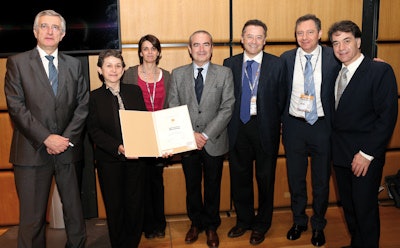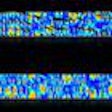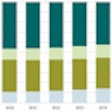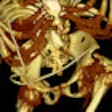
VIENNA - It was not entirely predictable, but Friday's "ESR meets Spain" session held the door wide open for whatever came its way. On this occasion, it manifested as an exploration somewhat off the beaten track of mainstream radiology, by discussing the parallels between biomarkers and Spanish wine.
So why choose to focus on wine when the country has magnificent oranges, cultural icons, and sporting legends? Dr. Luis Martí-Bonmatí, PhD, from the hospital La Fe de Valencia in Spain told us why.
In the interlude slot between ischemic stroke and aortic aneurysms, he addressed the relationship between Spanish wine and imaging biomarkers, asking whether biomarkers of wine existed, and if so, what were the main end points of fine wine quality. Martí-Bonmatí has a specialist interest in imaging biomarkers.
"Before continuing, I have to inform you that this talk will not discuss Spanish wineries owned by radiologists, of which there are a few, nor the best Spanish radiologist wine drinkers, of which there are also a few," he jested.
He set the scene by describing an imaging biomarker: a characteristic of a tissue that can be objectively measured and that represents a parameter of its biological, functional, or structural organization. An imaging biomarker explains, quantifies, and spatially represents a tissue-specific property. By comparison, Martí-Bonmatí asked whether equivalent parameters of wine existed in any shape or form.
"I believe wine biomarkers are any characteristics of the wine-related production process that can be objectively measured, representing a biological, functional, or structural property," he argued. "We may want to know which parameters relate to wine quality. I chose biomarkers related to the soil, which is an important aspect of wine production."
Starting with the basics of growing a vine, Martí-Bonmatí explained how a vine needs to grow in water, sunlight, air, and a mix of trace elements and nutrients. To his knowledge, nobody has been able to objectively show any confirmed links between the soil mineral composition, the altitude, and the flavor or fragrance of wines. Wines from a particular terroir, however, do express characteristics related to the physical environment in which the grapes are grown.
"The combination of a certain vineyard's site and the grape varieties creates a unique wine that faithfully expresses the geographical origins and locations. So just as we sense the world around us and use this information to guide our actions, so do vines," the Spanish radiologist and wine enthusiast pointed out.
So what geographical features does Spain have that could influence the vine and ultimately the properties of its produce? Martí-Bonmatí explained that Spain was a peninsula and as such had a wide variety of climates and many rivers: Atlantic, continental, mountain, Mediterranean, and arid central zones. The soil pH also is of particular importance to the growth of vines, with around half the country acidic at a pH of less than 5, and other areas up to pH8. A large part of the soil is siliceous, with the remainder a mixture of limestone and clay. Altitudes can reach 2,000 meters in places.
"Don't forget the biomarkers of rain, temperature, and sun irradiation. End points are surrogate markers for the underlying process. In medical research, this could be biological, physiological, or a clinical change, but for wine the end point is quality, as assessed by expert opinion and consumer acceptance," Martí-Bonmatí said.
 ECR 2013 President Dr. José Bilbao (center) congratulates Dr. Luis Martí-Bonmatí, PhD (third from the right), and his fellow Spaniards during Friday’s session. Image courtesy of the European Society of Radiology.
ECR 2013 President Dr. José Bilbao (center) congratulates Dr. Luis Martí-Bonmatí, PhD (third from the right), and his fellow Spaniards during Friday’s session. Image courtesy of the European Society of Radiology.Despite not conclusively identifying which geographical biomarkers were associated with the best or worst quality Spanish wine, he did show a map of Spain with Parker wine scores, arguably an end point, superimposed on top. It will come as no surprise that wines with a Parker score of 98 to 100 were located north of Madrid in the north central region, which locates to the Castilla Leon and La Rioja regions. In terms of biomarkers, these areas have relatively high altitude, limestone soil, and average rainfall and levels of sunshine.
European Society of Radiology (ESR) President Dr. Gabriel Krestin introduced the Spanish "ESR meets" session, which is an annual series aimed at strengthening ties among colleagues internationally.
"It is a tradition that amongst the countries invited for such a session is the ECR president's own country," he noted. "The ESR has strong ties to Spain with nearly 2,500 colleagues in Spain as ESR members. Around 400 attend the ECR each year. Three officers of the ESR come from Spain, and we have over 400 Spanish abstracts submitted each year in the recent past. This year is another testament to the high quality of research from Spain."
Originally published in ECR Today on 9 March 2013.
Copyright © 2013 European Society of Radiology











